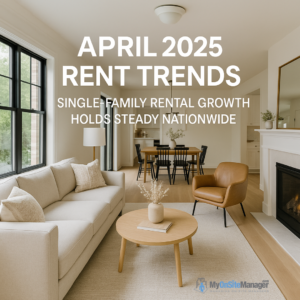The U.S. rental market is showing signs of stability—at least for now.
According to the latest data from CoreLogic’s Single-Family Rent Index (SFRI), U.S. single-family rents rose 2.9% year-over-year in April 2025—matching the same growth rate recorded in March. While a far cry from the double-digit spikes seen during the pandemic peak, this level of growth points to a rental market that’s finding its footing in the face of high interest rates and tight housing supply.
What’s Driving the Numbers?
A big part of what’s holding rent growth steady is a persistent lack of for-sale housing inventory. With mortgage rates remaining elevated, many would-be homebuyers are opting to stay in the rental market, keeping demand strong—especially for single-family homes.
However, there’s more to the story when you break it down by rental class and property type.
-
High-end rentals (larger, newer homes in premium locations) saw a 3.5% annual increase, up from 3.0% a year ago.
-
Low-end rentals, on the other hand, rose just 2.5%, down from 3.2% the year before.
This shift signals that higher-income renters are driving more of the current demand, while lower-income households may be reaching their affordability limits.
Even the type of property matters. Attached rentals (like townhomes and duplexes) slightly outperformed detached homes, with growth of 2.7% compared to 2.4%. Smaller size and location likely play a role here—making attached rentals a more accessible option for many families.
The Metro Breakdown: Where Rents Are Rising—and Falling
Not all cities are experiencing the same rental trends. Some are heating up fast, while others are finally starting to cool off.
Markets With the Fastest Rent Growth
-
New York–Jersey City–White Plains: +5.4%
-
Chicago: +5.3%
-
Detroit: +5.1%
These markets are benefitting from strong job growth, limited rental supply, and continued demand for urban living.
Slowing or Declining Markets
-
Dallas: –0.4%
-
Miami: +0.6%
What’s behind the drop? Oversupply. Cities like Dallas have experienced a boom in new construction over the last couple of years, giving renters more choices and landlords less pricing power. Miami’s rent growth is also easing after years of sky-high increases, possibly hitting a ceiling in affordability.
What to Watch Going Forward
While national rent growth appears stable, the outlook is far from uniform.
Here are a few trends to monitor:
-
Rising inventory in key markets like Phoenix, Atlanta, and Dallas could further cool rent prices.
-
Affordability pressures will likely continue to limit rent hikes in lower-income areas.
-
Interest rate movements will play a big role in keeping renters in place—or encouraging homebuying.
CoreLogic’s upcoming reports for May and June 2025 will be key to determining whether we’ve truly hit a plateau or are on the cusp of another shift.
Final Takeaway
The April 2025 rent data shows a market in transition: no longer in a post-pandemic boom, but not exactly slowing down either. Strong demand is keeping rents afloat—especially in high-cost metros and luxury segments—while oversupplied markets and affordability ceilings are pulling others down.
For renters, landlords, and investors alike, the message is clear: local trends matter more than ever.
Original Source: Multi-Housing News – U.S. Single-Family Rent Index

